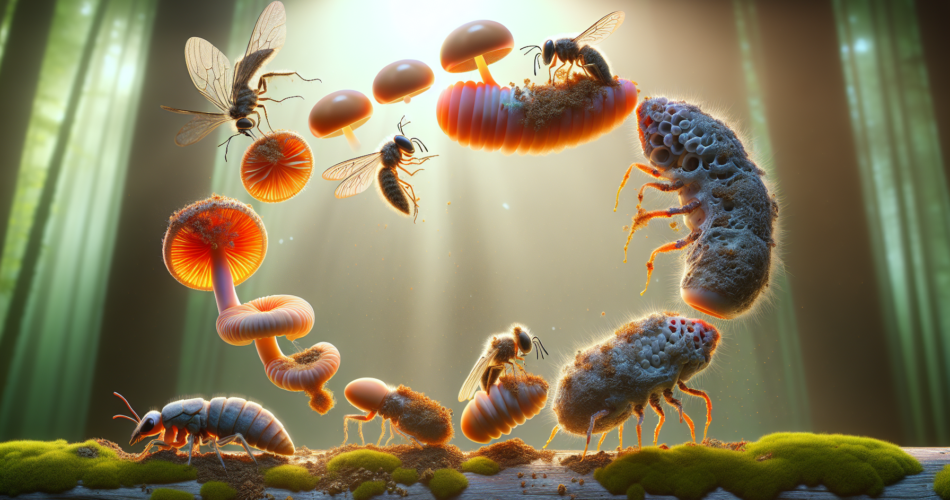In the complex tapestry of nature, few phenomena capture the imagination quite like the Ophiocordyceps fungus. Known for its uncanny ability to manipulate the behavior of insects, this parasitic fungus has earned the moniker "nature’s zombie insect manipulator." The relationship between Ophiocordyceps and its insect hosts provides a compelling glimpse into the intricate dynamics of parasitism and survival. As researchers delve deeper into the life cycle and mechanisms of this fascinating organism, the implications for ecology, evolution, and even potential medicinal applications become increasingly apparent.
Unveiling the Secrets of Ophiocordyceps: Nature’s Zombie Maker
Ophiocordyceps fungi are renowned for their remarkable ability to hijack the nervous systems of their insect hosts, particularly ants. Upon infection, the fungus releases chemical compounds that influence the host’s behavior, effectively turning it into a puppet. The most famous example is the Ophiocordyceps unilateralis, which targets carpenter ants. Once infected, the ant exhibits a peculiar behavior known as "summit disease," where it climbs vegetation and attaches itself to a leaf or twig, providing an ideal microenvironment for the fungus to thrive. This bizarre behavior is a striking illustration of nature’s complexities and the dark side of evolution.
The biochemical processes behind this manipulation are still being studied, but initial findings suggest that the fungus produces specific proteins and compounds that interact with the ant’s neurochemistry. Researchers have identified certain metabolites that may act like neurotransmitters, effectively reprogramming the ant’s brain. This phenomenon raises questions about consciousness and the extent to which a host organism can be controlled by a parasite. It illustrates an extreme example of parasitic adaptation, showcasing the lengths to which organisms will go to ensure their survival and reproductive success.
Beyond their macabre behavior, Ophiocordyceps fungi have captivated scientists due to their potential applications in medicine and pharmacology. The compounds produced by these fungi have shown promise in the treatment of various ailments, including cancer, infections, and inflammation. The study of Ophiocordyceps is not merely an exploration of the bizarre; it is a path toward discovering novel therapeutic agents that could revolutionize modern medicine. As we unlock the secrets of these fungi, we may come to appreciate them not only as nature’s manipulators but also as vital contributors to medical science.
The Intricate Life Cycle of the Ophiocordyceps Fungus
The life cycle of the Ophiocordyceps fungus is a marvel of evolutionary engineering, beginning with spore dispersal. The spores are typically released into the environment and cling to the bodies of unsuspecting insects, often during the warmer months when insect activity is high. Once a spore successfully attaches to an insect host, it penetrates the exoskeleton and begins to colonize the host’s tissues. This initial stage is crucial, as the fungus must evade the host’s immune response while starting to manipulate its behavior.
As the fungus grows inside the host, it releases enzymes that break down the insect’s tissues, using them as a nutrient source. The manipulation intensifies as the fungus produces various bioactive compounds designed to alter the host’s nervous system. This stage culminates in the host climbing to a high point, where it ultimately succumbs to the infection. After death, the fungus continues to grow, eventually producing a fruiting body that protrudes from the host’s remains, often resembling a stalk or club. This grotesque yet fascinating process illustrates the intricate connection between life and death in the natural world.
When the fruiting body matures, it releases new spores into the environment, completing the life cycle. This cycle can occur in various environmental conditions, allowing Ophiocordyceps fungi to thrive in diverse ecosystems. Interestingly, the fungi also display remarkable specificity for their hosts, often showing a preference for certain species of insects. This relationship highlights the co-evolution of parasites and hosts, as insects develop behavioral defenses and immune strategies to fend off infections while fungi continue to refine their manipulation techniques. Studying this life cycle sheds light on the broader ecological implications, including the role of parasites in regulating insect populations and their contributions to biodiversity.
The Ophiocordyceps fungus stands as a testament to the extraordinary complexities of nature’s design. Its ability to manipulate the behaviors of its insect hosts not only challenges our understanding of parasitism but also opens up new avenues for scientific exploration. As we continue to unravel the mysteries behind this fascinating organism, the potential implications for medicine and ecology remain significant. Understanding the delicate balance between hosts and parasites like Ophiocordyceps will not only enhance our knowledge of evolutionary biology but may also lead to groundbreaking advancements in health and disease management. Nature, it seems, still has many secrets to unveil.

